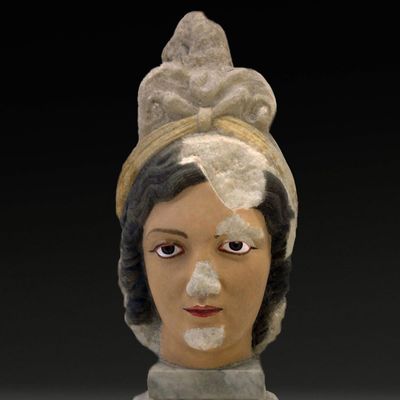
The opening of Francesco Vezzoli’s new exhibition of very old marble heads at MoMA PS1 on October 26 wasn’t an especially imperial affair — and it wasn’t just because it was in Queens on a blustery Sunday. Vezzoli, who grew up in Italy but went to art school at Central Saint Martins in London, has become a favorite of the art-and-fashion set: Miuccia Prada has long been a patron, and Visionaire’s Cecilia Dean, W’s Stefano Tonchi, and Derek Blasberg of Harper’s Bazaar joined the museum curators and art-world enthusiasts (Jeffrey Deitch, Justin Vivian Bond) to toast the installation. (Later, they retreated to Diana Picasso’s for dinner, where they were joined by Marina Abramovic and Matt Dillon.)
Vezzoli first became well-known for his needlepoint, a dreamy, inwardly focused activity, but soon his work turned into more of a depiction of the pageantry he’d dreamed about. (That phase reached its blockbuster apogee with his 2006 trailer for an imaginary remake of Gore Vidal’s Caligula starring Helen Mirren, Milla Jovovich, and Courtney Love, among others.)
Since then, Vezzoli, who grew up reading Greek and Latin at his high-intensity high school outside of Milan, has continued to play with some idea of his country’s somewhat-beleaguered cultural patrimony. This show, called “Teatro Romano,” consists of five classical busts that Vezzoli has repainted with the help of a team of restorers. Most everything we think of as bleached-white, ancient statuary misses the essential fact that they were originally painted sometimes garishly.
“There are all these people who are theorizing about the presence of color in sculpture and soon we will have more and more and more books, which will try to reeducate our understanding of what classicality means,” Vezzoli says when I meet him for breakfast at the Mercer Hotel (where he orders only mint tea with a side of soy milk). “Have you ever seen the Ara Pacis in Rome? The big mausoleum of Emperor Augustus. This thing, which now seems like an exercise in purity, which we could aesthetically analyze as the perfect tension between content and lack of emotion — instead, when it was new it was painted like a Versace scarf. It was unbearable, it was tacky, it was kitschy.”
His intent in this exhibition is partly to reveal what the originals looked like, but also to show how we have misread them. He shows me a picture on his iPad of one of the heads, now painted. Without pigment, “it looked like Russell Crowe — very sexy.” But now that it is colored as it once was, “it looks like just a peasant from the country outside Rome with a lost gaze. It changes completely the perception of the object, the meaning, the sensuality, it’s — shocking.”
The show is based on scholarly research: After he bought the heads at auction, he worked with NYU professor Clemente Marconi — “I am not respected. He is very respected” — to paint them as accurately as they could.
But it’s also a comment on how Italy has little left but its past. “The attics of Italy are full of this stuff. Our cultural heritage seems to be the biggest global asset we have. So this exhibition is way more political than most people in America will get.”
There’s one more layer to it: He mentions how much less a piece of classical sculpture sells for than, say, a Wade Guyton print. When he buys the old statues in auction, “it’s always much lower than one would expect,” he says. Though he admits now that they’ve become touched by Vezzoli, and therefore infected by the contemporary art market, they will resell for “more than I paid for them.”
Spotlit in vitrines and PS1, though, the effect is theatrical: They look a bit like they’re tarted up for a night on the town, like drag queens, or maybe Dirk Bogarde in Death in Venice. He laughs. “Someone actually proposed me to do a further chapter with Pat McGrath and I thought, Why not?”




